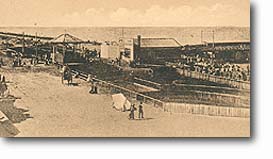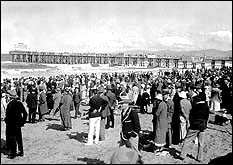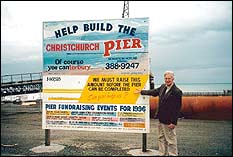Dorothy – 12/04/02
|
|
| The Pier today Photo source Peter Dunbar |
Interest in New Brighton from 1860 New Brighton has been a place for enjoyment for Christchurch citizens and visitors since 1860. In that year five men had walked through the dense undergrowth, toe toe, flax and swamp to reach the beach.
One of the men, Thomas Free, who was a carpenter, built a cottage on the river Avon not far from the present township and beach, and chalked on a board outside the words ‘New Brighton’.
Transport to New Brighton Transport to the beach was very limited at first – just an infrequent coach service. In 1872 a daily service began and in 1879 the coaches ran a twice daily service. The area proved so attractive that by 1887 a tramway was built with first horse-drawn, then steam and later electric trams serving the area. The horse-drawn trams covered the distance in forty five minutes, and the faster steam trams took twenty five minutes.
Development at the beach In 1872 Mr J. H. Hopkins bought 60 hectares of what seemed like a sandy waste in the area where the town and shopping centre now stands. He built a hotel on the Esplanade and set out to attract people to visit. He had a paddle steamer built to accommodate seventy passengers and run on the Avon River between Christchurch and New Brighton. It would also serve the purpose of keeping the river clear of weeds and watercress. The steamer was launched by the Mayoress and named ‘The Brighton’. Passengers lunched at Mr Hopkins’ hotel and a second party was taken there for a ball in the evening. Mr Hopkins advertised that two return trips to Brighton would be made each day and that special arrangements could be made for picnic parties.
Parties who travelled by the steamer in the first months of its operation included the Christchurch Fire Brigade annual picnic, the Methodist ministers and their wives attending a Methodist Conference, and the St Michael’s Sunday School.
Unfortunately Mr Hopkins ran into financial problems and by the end of 1874 he had to sell both the paddle steamer and the hotel. Other attempts to develop a passenger service on the Avon did not succeed.
Borough of New Brighton established in 1897 At first New Brighton was regarded by most people as a place to visit rather than to settle, but by 1889 670 sections had been sold and by 1897 the borough of New Brighton was established.
Pier begun in 1891 – opened in 1894 In 1888 some New Brighton residents held a meeting to discuss building a pier at New Brighton and formed the Pier Company. They decided to build a pier 700 feet long and 20 feet wide with an approach 30 feet wide. The piles were tarred ironbark and the beams were kauri with iron brackets to brace them. The first pile was driven in May 1891. They were driven about twelve feet and were twelve feet high above the water.
In January 1894 the New Brighton Pier was opened by the Governor of New Zealand. He had to walk along the Pier under umbrellas because it was a wet day.
Charles Agar buys and develops the Pier One year after the Pier was opened it was bought by Charles Agar, a Lyttelton store owner and later a borough councillor. All that had been built was the Pier and a turnstile at the entrance. He used initiative in developing the Pier. He introduced a fun arcade with slot machines where you could get character reading and horoscopes, have your fortune told, or experience an electric shock. To use the electric shock machine cost one penny, but friends would join hands so that a number of people could all experience the shock for the same penny. When the 1906-7 International Exhibition held in Hagley Park closed, he bought a number of the slot machines used there.
He had an Edison phonograph on which he played cylinder records and fitted a large sound horn to amplify the music for the crowds. For many people this was the first time they heard recorded music so it was very popular and special seating was set up for people to sit and listen. Many people’s memories of the Pier include music. Orchestras played in the ballroom built at the Pier, and dancing there and walking on the Pier in the moonlight became very popular. Bands played in the rotunda near the pier.
|
|
| The Pier and the band rotunda in 1912 |
|
|
| The Pier in 1916 Photo source Peter Dunbar |
|
|
| Crowds at the Pier in the 1920s Photographer James Buick Photo source Kay Barrett |
|
|
| Father Christmas procession in New Brighton Photo by permission of Harold Mason, now Nelson photographer |
For a time the ‘John Anderson’ a coastal steamer which operated around Banks Peninsula made trips from Lyttelton to the Pier. Mr Agar added tearooms, an ice cream shop and dressing sheds. About 1900 the Pier was proving so popular that Mr Agar employed a manager, William Taylor. He had a variety of duties in addition to the administration – removing fishhooks from the fingers of little boys fishing from the Pier, washing it clean of pipis which people had brought on to the Pier to use as bait, washing the bathing costumes and boiling the towels which were available for hire.
He was so busy that by 1928 he asked his brother Arthur and his wife and daughter to help in the running of the Pier.
In 1909 a gala was held at New Brighton and the trams carried 14,107 passengers to the beach. The programme included canoe races, castle building, sand model competitions, children’s sports, swimming and sunbathing and fancy dress parades.
Financial problems and need for repairs lead to demolition In spite of his innovations and the popularity of the Pier Charles Agar could not make it profitable. He leased it out for some years and in 1950 it was bought by L. H. Duffield. He put up new rails and replaced two piles, but the Pier was in a dilapidated state and despite the best efforts of Mr Duffield and the Pier and Foreshore Promotion Society it proved impossible to raise the necessary funds to restore the Pier. In 1965 it was demolished.
Saturday shopping With the introduction of the 40 hour week, shops in the city of Christchurch were closed on Saturday from 1945 to 1981. Shopping in New Brighton on a Saturday became a popular outing for Christchurch people. For most of that time the Brighton shops were closed on a Monday.
Harold Mason, a professional photographer in New Brighton, took a photo of the Saturday crowds when Father Christmas arrived in New Brighton in December 1965. The Pier buildings are visible at the end of the street.
Peter Dunbar, Chairman of the New Brighton Pier and Foreshore Promotion Society, reports on the work that led to the new pier. It was over thirty years before there was a new pier. The New Brighton Pier and Foreshore Promotion Society stayed together after the failure to save the first pier from destruction. The members met regularly, monthly, having resolved to use their energies to encourage improvements to the foreshore. Their first success was the construction by the City Council of the central children’s play area, which the Society had promoted, and for which they had paid the design fees.
Improvement projects for the sea front Many other improvement projects were sponsored and seen through to completion, not only in the central New Brighton area, but ranging from the Waimairi beach front to the South Brighton Surf Club. The Society also promoted the securing and development of the river-bank area once resourced by the noted botanist Leonard Cockayne. Members planted shrubs and arranged fencing, eventually ensuring that the area was officially named as the Leonard Cockayne Reserve.
Plans for a new pier Always the group kept as an eventual target the building of a new pier. Over the years, especially during the hey-day of exclusive Saturday shopping in New Brighton, a fund-raising team ran events in the main street mall, steadily accumulating thousands of dollars.
Amalgamation of the Christchurch boroughs During the 1980s the amalgamation of the various boroughs of Christchurch with the City Council made for a unified administration with new city-wide policies.
Pier Promotion Trust established
|
|
| Peter Dunbar beside the billboard advertising the 1996 fundraising Photo source Peter Dunbar |
In 1989 the Pier & Foreshore Promotion Society committee felt that the time had come to press for a new pier. The Society established a special Pier Promotion Trust, funding this with a grant of $50,000. Members from the wider community – Lions, Rotarians and women’s groups – were appointed to the Trust, and the long period of planning, fund-raising, with the seeking of necessary consents, began.
From the first the City Council was kept informed of the Trust’s hopes and ambitions. At first rather doubtful, City Councillors were slowly persuaded by the efforts of the Trust, and by the results of various studies and surveys, that the plans had validity.
Planning and costing begun Eventually, when a plan drawn for the Trust by a City Council design team was professionally costed at $4,000,000, the Council offered to provide up to $2,000,000 if the Trust could raise $2,000,000. The trust had by then assurances of over $1,000,000.
The new pier was to be half as long again as the old pier ( 300 metres instead of 200 metres) and the deck wider and 2 metres higher above beach and sea. The Pier Promotion Trust concerned itself with the pier, and immediate access, it being agreed that any land-based structure on the specially zoned foreshore area would be for Council decision. When put to tender the pier itself was contracted for at $2,900,000. It took two years to build.
Opening of the new pier
|
|
| A Maori leader speaking at the opening ceremony Photo source Peter Dunbar |
The new pier was opened with temporary access on November 1, 1997. A function was held at dawn with Maori ceremonial, followed by an opening ceremony at 8 am with the Mayor, Ms Vicki Buck, officiating.
Massive fund raising achieved
The New Brighton community, with help from some larger donors such as the Christchurch Community Trust, and the Lotteries Board, eventually raised a total of $1.630,000.
The Pier calendar A 1998 calendar featured photos by Peter Seymour, a Christchurch photographer. These photos show different stages in the construction of the Pier, and some can be seen in the Photo Supplement to this article. We are grateful to Peter Seymour for giving permission for us to use them.
The land-based connection and establishment of a library The new pier was immediately popular, but the question of the important land-based connection remained open for some time. By fortunate coincidence, planning had been underway for some years for a major library building for the suburb, patronage having outgrown the capacity of the small existing library. Somewhat to the surprise of City Council planners, the librarians concerned found a seaside site an attractive prospect.
|
|
| The new library complex Photo source Peter Hunt |
Designs were prepared by a prominent architect, with a particular view to accommodating modern technologies. Room for a lift and restaurant facilities completed the concept, the final design bringing the architect national acclaim. When completed in early 1999 the integrated complex of pier and library, with access ways, delighted the early planners and indeed the whole community. Their best hopes had been exceeded.
The new Library/Pier complex was declared open in June 1999 by the newly-elected Mayor, Mr Garry Moore.
Click here to view the photo supplement on the construction of the New Brighton Pier – from Peter Seymour’s Pier calendar photographs












